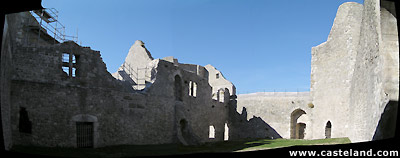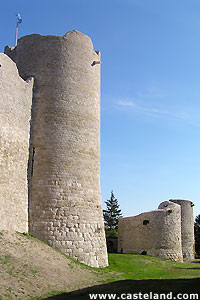|
History of the castle

Located on a spur, in extreme cases
of old évéchés of Orleans and Direction, of
which the Essonne and Rimarde marked the border, Yèvre-le-Châtel
was very early strengthened.
As of Xème century, Yèvre is one of the possessions
of the Abbey of Fleury de Saint-Benoit-sur-Loire. It is known that
on several occasions the monks of Fleury complained with the King,
Hugues Capet, of the exactions of the baron Arnoul de Yèvre.
It is undoubtedly to make forget excesses of her husband whom his
wife, Lucinde, founded in the enclosure of the chàteau an
abbey under the invocation of Saint-Gault, one of the Saints of
Brittany whose relics had been brought in the area by monks fleeing
the invasion of the Norman ones. The vault of this abbey is today
the parish church of Yèvre-le-Châtel.
After the death of the baron Arnoul, the King will intervene several
times to subject his successors and to dismantle their castles which
were to be only wood forts, built on a "mound".
 The
fastening of the castle to the crown of France is probably about
1112, when Louis VI the Large constrained Foulques Viscount to yield
Yèvre-le-Châtel to him of which it made powerful a
chàtellenie. The
fastening of the castle to the crown of France is probably about
1112, when Louis VI the Large constrained Foulques Viscount to yield
Yèvre-le-Châtel to him of which it made powerful a
chàtellenie.
About 1200, on order of Philippe Auguste, the castle was rebuilt
according to last improvements' of the military architecture brought
back of the crusades. It is apparently in Gilon of Tournel that
one owes this ultimate rebuilding.
During the One hundred year old war, Yèvre remained, with
Montargis, the only fortified town in the north of the Loire not
to fall between the hands from the English or the Burgundian ones.
With the end of XVème century, because of extension of the
royal field and progress of the artillery which made its defenses
obsolete, Yèvre-le-Châtel lost of its importance and
its role of fortified town. An inventory already indicates, in 1610,
that the castle is in ruin.
In 1637, the constabulary will be transferred to Pithiviers, but
royal justice will continue to sit at Yèvre until the Revolution.
|




 The
fastening of the castle to the crown of France is probably about
1112, when Louis VI the Large constrained Foulques Viscount to yield
Yèvre-le-Châtel to him of which it made powerful a
chàtellenie.
The
fastening of the castle to the crown of France is probably about
1112, when Louis VI the Large constrained Foulques Viscount to yield
Yèvre-le-Châtel to him of which it made powerful a
chàtellenie. 
